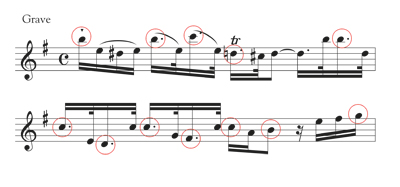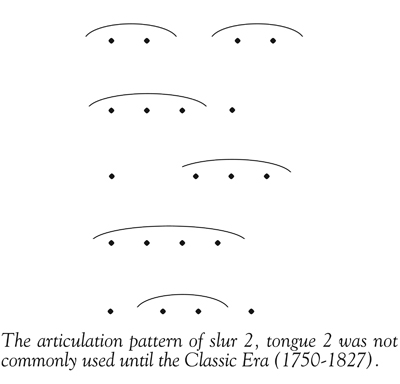Baroque music (1600-1750) can be thought of as antique music. Just as people restore an historic home or antique car, students preparing a Baroque sonata for performance will follow similar steps.
Go to the Source
Find the manuscript or earliest edition of the music. Decipher as much as possible of the composer’s original intent. Unfortunately, many modern editions are heavily edited in a well-meaning attempt to give students information about Baroque performance traditions that was not included the original printed edition. For example many Baroque composers notated recommendations for articulations, dynamics, and sometimes ornamentation only in the first bars of a composition, and Baroque performers may or may not have followed these ideas. A comparison of a manuscript to an edited version will show what is original and what was added later. For students to make informed choices, they should know what indications are suggestions by editors.
If students are not playing from an urtext edition, they should photocopy the music and white-out the editor’s markings. Below are examples which illustrate some of the differences between part of the Grave movement of the original Rogers Edition of the Handel Sonata in E Minor HWV 359b, a modern urtext edition, and a final version after editorial choices were added to the urtext edition.
Original Edition
.jpg)
Modern Urtext Edition
.jpg)
Editorial Changes to Urtext Edition
.jpg)
Practice Baroque Rhythm
Because Baroque music was based on the idea of dancing, the strength of the beat rule was used. Beats were considered to be strong (good) and weak (bad). In 2/4 meter, the first beat was strong and the second was weak. In 3/4 meter, the first beat was strong, the second weaker, and the third weakest. In 4/4 meter, the first beat was strong, the second weak, the third less strong, and the fourth weaker.
In performance musicians counted the music in their head the way we would today; but tapped their feet according to a different set of principles. Today in a 4/4 meter composition that is played alla breve, players tap a downward motion on beats one and three, but in the Baroque, musicians made a downward foot tap on one and an upward motion on beat three. In 3/4 meter, players tapped a downward motion on beat one and an upward motion on beat three.
Interestingly, this rhythmic tradition of tapping irregularly persisted into the early 19th century, as can be seen from part of a page of the celebrated 19th century British Flutist Charles Nicholson’s 1836 Flute Tutor, where he indicated this method for beating time with a D for tapping the foot down and a U for raising the foot up.
.jpg)
Students who adopt this rhythmic tradition often find that they have to learn to feel the music in their bodies. This recreates the dance-like style that was the origin of much of Baroque music. When students do this, they find that physically beating time as opposed to simply counting beats dramatically alters their performances. Modern performers may want to follow Nicholson’s system of marking the strong and weak beats with a D or U in relationship to tapping one’s foot, or simply use down and up arrows to simplify the process. Additionally, students can mark down and up practice arrows in their music as a performance aid.
Below are some examples of practice arrows which illustrate the authentic 18th century concept of beating beats in part of the duple meter Allegro and the triple meter Adagio movements of the of the Handel Sonata in E Minor HWV 359b.
.jpg)
.jpg)
Isolate and Practice the Simple Melody
Baroque era composers conceived their music in a very sparse format. The musical custom of the day was for performers to add any elaboration or ornamentation of the melody spontaneously as the work was being performed. This is similar to the process in which jazz players perform with only the outlines of chord progressions as their guide.
When performing from a modern edition that includes written out ornamentation, make a skeleton of the melody by removing all non-chordal material. Practice this skeleton and shape the phrase by playing the contour of the melody. As the notes ascend, they will gradually become louder, and as they descend softer. During subsequent repetitions, consider the dynamic design and articulation choices. Little by little add in the non-chordal tones recalling the basic skeleton of the melody. If musical issues arise, return to practicing the skeleton.
Circled notes below illustrate an example of a possible skeleton for the Grave movement of the Handel Sonata in E Minor.

Combine the Correct Rhythm and Melody
After practicing these two elements separately, combine the two activities. It may be helpful if the teacher plays the melody while the student taps a foot and then for the student to play the melody while the teacher taps a foot. If difficulties arise, return to practicing the two activities separately.
Some students find success by tapping both feet simultaneously, then tapping with alternating feet, before tapping with one foot only. Use a video camera to chart problems and progress.
Articulation and Ornamentation
A good source to consult in making articulation and ornamentation choices is the J.J. Quantz On Playing the Flute. Quantz recommended ornamenting lightly rather than over doing it. For ideas consult contemporary various Performer’s Editions to see what options modern day Baroque players suggest. Generally Baroque flutists employed the following articulation patterns:

Conjunct notes were often slurred and notes with wide intervallic skips were articulated. If in doubt, articulate the notes. Baroque composers often indicated articulations and ornamentation suggestions at the beginning of a composition and expected the performer to follow suit. Additional hints can often be found in the urtext score. The following are articulation suggestions (slurring in pairs or tongue 1, slur 3) given by Handel or his editor in the Allegro from the Sonata in E Minor HWV 359b.
.jpg)
Practice of the skeleton and Baroque rhythm will show students the important melodic and rhythmic elements of the music. Using this knowledge they can apply Handel’s suggested two articulation patterns to the rest of the movement. For example, Handel indicates that flutists should articulate the disjunct melodic patterns of chordal intervals in slurred pairs while the conjunct melodic patterns should be articulated as slur 1 tongue 3. Because skips were often articulated and not slurred, Handel may have deliberately indicated that these intervals should be slurred in pairs. Students can use this information to make articulation choices for the rest of the movement as indicated below.
.jpg)
Ornamentation ideas can also often be found in the urtext score. Students learning to ornament a Baroque sonata should consult other sonatas by the same composer. Many times Baroque composers wrote out ornamentation suggestions of a melodic idea in one sonata which could also be applied to another one. For example, a simple concept to use when learning to ornament is filling in the thirds. Looking at the Largo from the B Minor Sonata HWV 367b, Handel used the concept of filling in the third on the fourth beat of measure 8.
.jpg)
Students learning the C Major Sonata HWV 365 can see by consulting the B Minor Sonata that they could apply this concept to the C Major arpeggio in the third measure of the C Major Larghetto.

Creating a historically appropriate performance on a modern flute is a rewarding experience because you are respecting the composer’s work and the traditions of the period.






